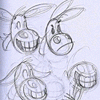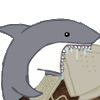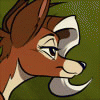
pencil, then digital.
This should hardly come as a surprise to folks who are following my journal
(though there's no real reason to do so).
I'm reading the old Arthurian myths (Le Morte D'Arthur), this is a creature from them.
The story has picked up considerably in Book Two - really good stuff,
actually, very surprising, lots of twists and turns. The pacing is strange
however; though the work is attributed to William Caxton in 1485, it reads
like something by multiple authors with different goals. Sometimes focus
lingers on battles, blow-by-blow, at other times significant clashes are
summarized in a single clinical sentence. Sometimes we follow Arthur
himself, sometimes we follow other characters that are basically stand-ins
for Arthur. There are practically three variations of Excalibur being
discovered and wielded within the first 100 pages. Anyway, a fine read.
This should hardly come as a surprise to folks who are following my journal
(though there's no real reason to do so).
I'm reading the old Arthurian myths (Le Morte D'Arthur), this is a creature from them.
The story has picked up considerably in Book Two - really good stuff,
actually, very surprising, lots of twists and turns. The pacing is strange
however; though the work is attributed to William Caxton in 1485, it reads
like something by multiple authors with different goals. Sometimes focus
lingers on battles, blow-by-blow, at other times significant clashes are
summarized in a single clinical sentence. Sometimes we follow Arthur
himself, sometimes we follow other characters that are basically stand-ins
for Arthur. There are practically three variations of Excalibur being
discovered and wielded within the first 100 pages. Anyway, a fine read.
Category Artwork (Digital) / Fantasy
Species Unspecified / Any
Size 1024 x 732px
File Size 194.5 kB
Le Morte D'Arthur spends a lot of time dicking around at the beginning in Book One, trying to introduce everybody and build the notion of all the knights as superhuman superheroes. When it actually sets up the plots and begins to actually tell interesting tales is in Book Two. I'm reading Sir Thomas Malory's version of the William Caxton texts. Go for it! :)
Reminds me of Dürer's rhino. My brother and I used to play a game in which one would describe an animal, and the other would try to draw it exactly from the description. The challenge was to describe the animal accurately without giving away what you were describing, and seeing if the person drawing it could guess what animal was being described from the drawing alone. We invented a number of previously unknown animals through that game.
What I'm wondering his how a giraffe got loose in the forest of Carlion?
What I'm wondering his how a giraffe got loose in the forest of Carlion?

 FA+
FA+























Comments